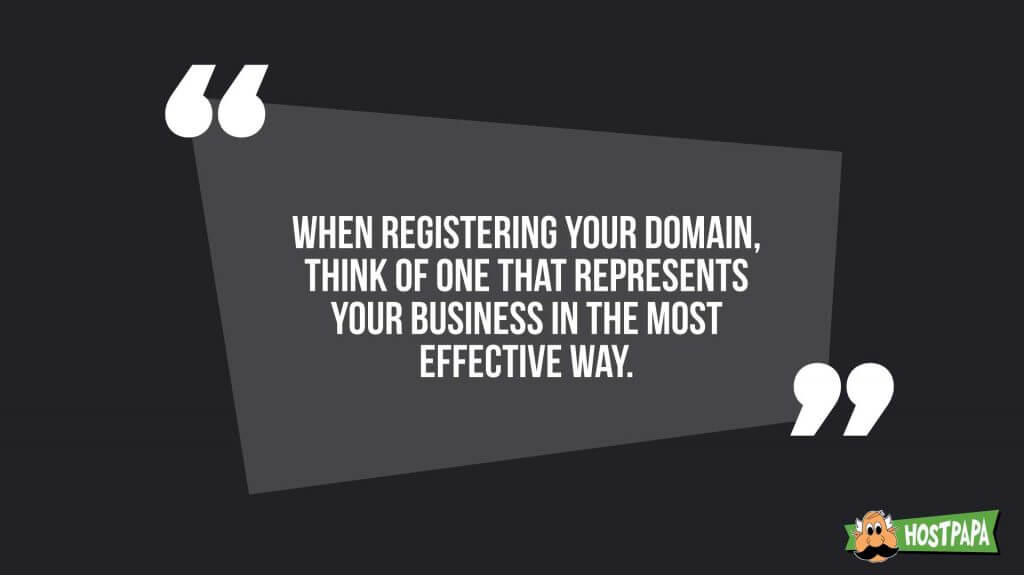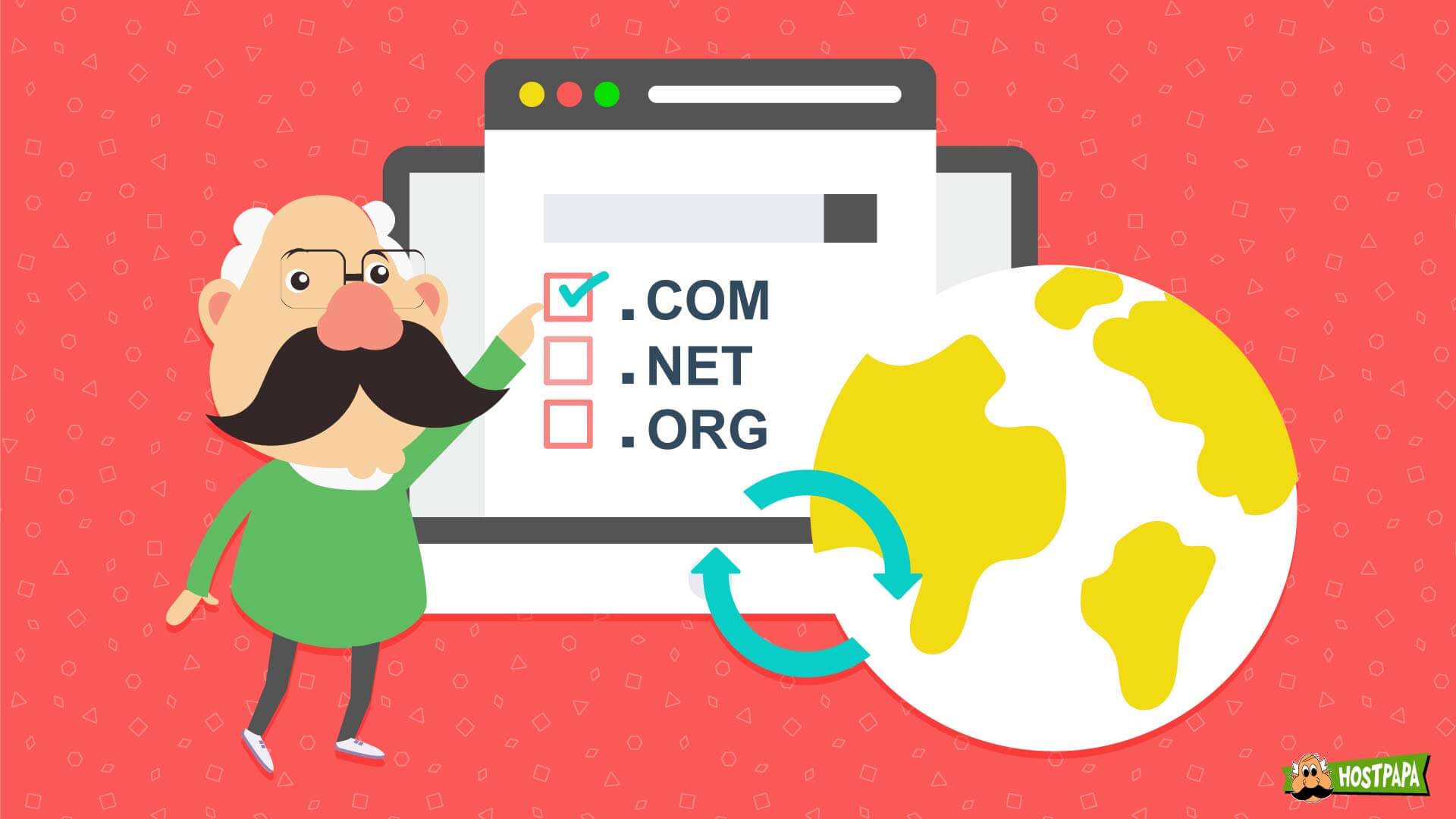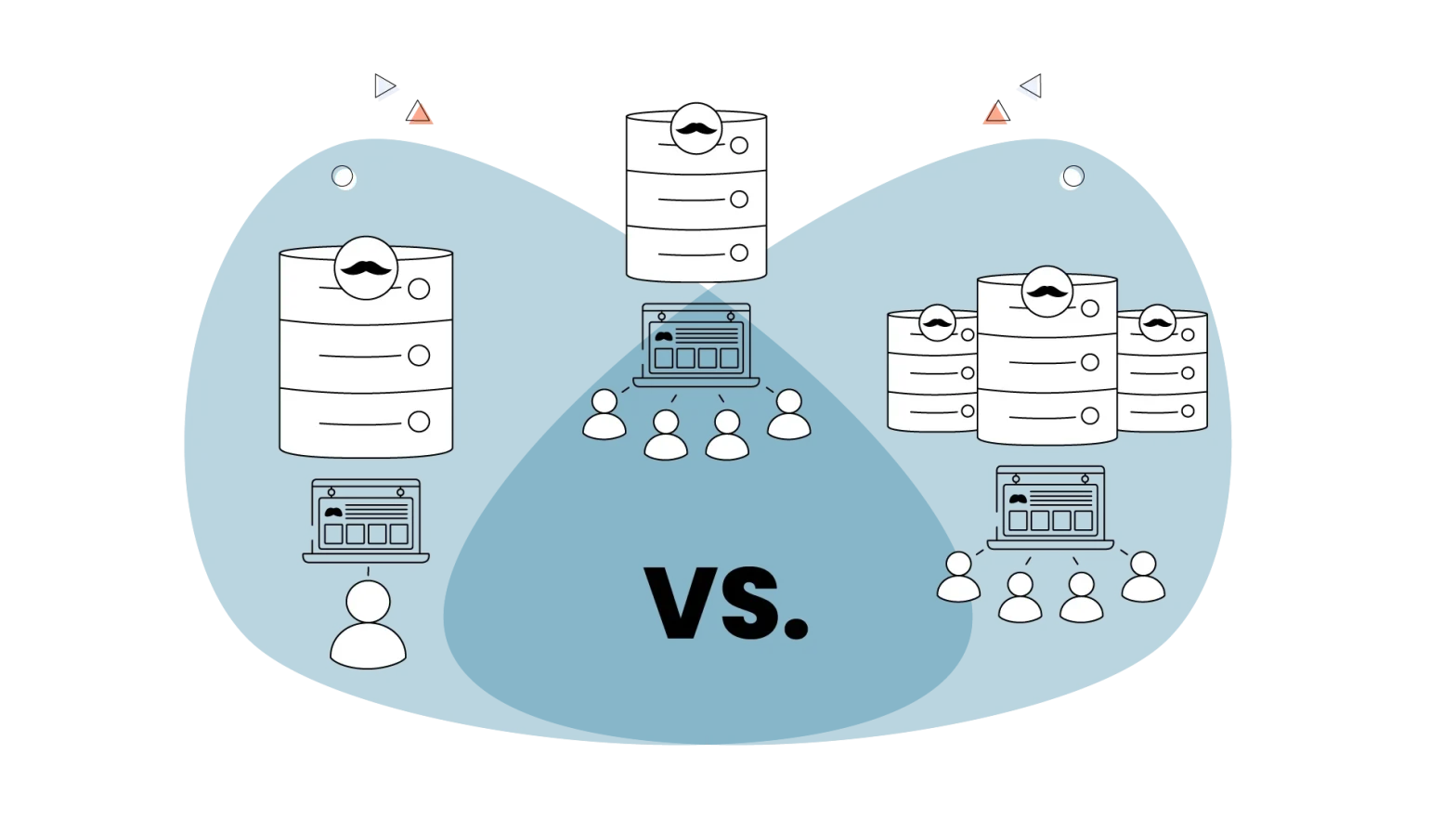One essential element of any website is its domain name. It’s what people type into the address bar of their web browsers to access a specific site, and it’s a major part of the site owner’s online identity.
When you buy a domain, you get the digital facade for your business.
For companies that do business exclusively online, a domain name can become synonymous with the company itself, as is the case with Amazon and its domain, www.amazon.com, for example.
If you are thinking about creating an online presence for your business, the best way to do that is by creating a website, and an authentic website cannot be created without buying a domain name.
Step by step, let’s talk about how you can buy a domain.
- Steps to Buying a Domain Name
- What is a Domain Name?
- Types of Domains
- How to Choose a Domain Name
- Multiple Domain Names
- What is Domain Registration?
- How to Register a Domain Name
Steps to Buying a Domain Name
Before we dive into the buying process, we’ll go over the basics of what a domain is, its types, how domain registration works, how you can purchase a domain and register it, and what costs you will have to bear. We’ll cover what’s involved in buying a domain and how important your domain can be for your business.
Let’s begin with the basics: what is a domain name?
What Is a Domain Name?
A domain name uniquely identifies a website and can’t be the same with other websites. If you look in your browser’s address bar, you’ll see the domain name of the site you’re visiting, like www.hostpapa.com, for instance.
While a domain name is associated with a website, they’re not the same thing. Every website also has an IP address, its official identifier on the Internet, but IP addresses are just a series of numbers. Accessing a website using its IP address instead of a readable domain name would be ineffective for internet users.
When your website is created, you, your web developer, or your web hosting company will associate the site’s IP address with the domain name you purchase. This isn’t a permanent decision – if you buy a different domain name in the future, it’s simple to redirect your website to the new domain.
When someone buys a domain name, the seller, known as the registrar, is often a web hosting company. Registering a domain name is typically handled by the web host, especially if you purchase a web hosting plan from the same provider.
Let’s look at what domain registrars are and how they fit into the domain registration process.
Types of Domains
There’s a wide variety of vastly different domains registered on the internet. To understand it simply, you just need to know the basic anatomy of domains, divided into two parts: SLD and TLD.
Second-Level Domains (SLD)
When most people think about naming their website, they think about second-level domains. If you have a business or a blog for which you need to make a website, you’ll focus on this category of website domains.
It’s an exclusive name representing your brand – because people remember a brand by its domain name, especially when its business is more online than offline.
A second-level domain appears to the left of the extension or TLD in a web address. The SLD can contain letters, numbers, and special characters – it’s totally up to you. However, it’s best to keep it as straightforward as possible so people can remember it easily.
Top-Level Domains (TLD)
Top-level domains are extensions that appear to the right of the SLD. That is why they are also known as domain extensions. TLDs are a series of letters that appear after the dot. The most common types of top-level domains are:
- .com – short for commercial
- .net – short for network
- .edu – short for education
- .org – short for organization
- .gov – short for government
- .mil – short for military
Some top-level domains are also related to different countries, such as .ca for Canada and .us for the US. Recently, some TLDs were invented to represent niche markets, such as .coffee, .ninja and .blog. Like SLDs, the price for TLDs varies based on their popularity or their ‘weight.’
How to Choose a Domain Name
Choosing the right domain name affects your business significantly. The domain name search is the first and most vital step to start from because it sends website visitors the right message about your business.
When website owners brainstorm about domain names, several ideas come to mind. While millions of domain names are available to purchase, many that are easy to remember are already taken.
Choosing the right domain name can be a challenging task. It requires another explanation to purchase a domain name from the owner already using it (don’t worry, though; we’ll shed some light on that, too).
Luckily, if you use a bit of imagination, you can still get the domain name that represents your brand exactly the way you want.
- Don’t Go for Generic Names
Names that are creative, memorable, and unique are always better than generic ones. After all, your domain name is one of the only things that people will remember your brand by.
What a lot of people mistakenly do is name their domain based on popular keywords. Although almost all of the variations of the popular keywords would be taken at this point, even if this works, it’s not the best idea. Instead, you should go for names that represent your idea and image instead of popular ones.
For instance, instead of besttechnologyfirm.com, you should go for adamstech.com – which sounds more trustworthy. While you may not have an online loyalty base right now, choosing the right domain is still the first step towards creating that, and you should be as creative as possible.
- Make Sure It’s Not Lengthy
Shorter domain names are always better. Even Google prefers domain names that are simple, easy, and short. You should be able to sum up whatever your message is in a short domain name. Aim for somewhere between six to 14 characters.
On the other hand, domain names full of numbers and special characters can quickly lower your rankings on the search engine because no one has enough time to remember all that.
There are three benefits of having a shorter domain name:
- They’re easier to read and remember.
- They take up less space on marketing materials, such as flyers and posters.
- They’re more catchy and can easily get stuck in a customer’s/visitor’s memory.
However, there’s a downside: very few good, short domain names are available at this point. If you use 100% of your uniqueness and creativity, this obstacle will become invisible.
- Avoid Numbers and Special Characters
While you’re allowed to use numbers and special characters in your domain name, we suggest you don’t – it simply doesn’t look good and isn’t efficient.
It would be hard to remember a domain name filled with numbers and hyphens. People would end up on the wrong websites by mistake.
The way around this problem is to use a domain name with just letters and make it unique. If a number makes your domain name look cooler and allows it to make more sense, then add it, such as “pizza4you.com” or “6senses.com.”
How to Choose the Right Domain Extension
Choosing “.com” is still the best way to go when choosing a TLD or extension for your domain name unless you have a reason to go for another option.
Around 43% of all the domains on the internet have “.com” as their extension. This means that this extension is what people are most familiar with and most expect.
If you cannot find a “.com” TLD with your domain name, you can use “.net,” another popular extension. However, if you choose any extension other than “.com,” look at the type of website currently associated with the same domain name but another TLD.
If a site with the same (or highly similar) name sells offensive, fishy, or shady content, then you might want to steer clear because people are bound to go mistakenly on that site and prejudge you.
Another important thing is to avoid niche TLDs like .club, .coffee, etc., unless you are sure they can enhance your brand.
The best domain name search tool is undoubtedly search engines. Another great domain search tool is HostPapa’s domains page, which is dedicated to that purpose. The perfect domain is waiting for you there! Remember, all our web hosting solutions come with a free domain registration for 1 whole year!
Multiple Domain Names
If you create a website from scratch, this might not be relevant to you. However, suppose you already have an operating website that publishes regular content. In that case, you might want to stick to this, especially if you are wondering about creating a second domain name for your website.
You can create a second (or multiple) domain name for your website, but ask yourself some questions before deciding on that.
Do You Need Another Domain Name?
Some website owners believe they need another domain because it seems divided, but that’s not enough reason. People create second domain names to divide the content on their website instead of thinking of more creative and categorical division methods.
One way is creating subdomains. By doing that, you can create a domain inside your original domain, meaning all the traffic will be generated to one site only, regardless of whether the visitors are on the subdomain or domain.
If a subdomain solves your problem (and it probably will), you don’t need to complicate things with multiple domain names.
Are Multiple Domains Good for Your Website?
In short, no. Multiple domains are unsuitable for your website and don’t have a good impact on your SEO efforts. It’s an ancient practice that should be abandoned now that there are more creative ways to categorize data on a website than in another domain.
Using more than one domain for one website confuses the search engine and breaks the domain’s authority – an essential ranking factor. If you have two domain names for one website, the traffic is bound to be divided, which means that neither website would rank well. On the other hand, if you categorize the website’s content with subdomains, all the traffic will be on one domain to boost your traffic.
How Much Does a Domain Name Cost?
According to expert answers, a new domain name should typically cost you somewhere between $9 to $15. However, these prices can differ based on the domain extension chosen. We recommend that you choose good and reliable web hosting companies to save the cost of your domain. Depending on the registrar company, your domain cost can decrease or increase due to the registration fee.
Now that you know all about domains, their types, anatomy, costs, and the perfect way to create them, let’s shift to the domain registration process, which will get your preferred domain name registered online.
What Is Domain Registration?
Domain registration is when a website owner purchases a domain name from a domain name registrar.
When you’re shopping for a domain name, you’ll find an extensive and competitive marketplace with many registrars to choose from. It will be easy to select and purchase the domain name that perfectly suits your business. You can get one with a popular extension, like .com, or you may choose a cutting-edge extension like .club or .menu.
To this point, we’ve only discussed the idea of purchasing a domain. You can get a domain name for free, but it’s not advisable.
Website-building brands like WordPress and Squarespace will let you use a subdomain like yoursite.wordpress.com. For most businesses, that sort of domain just won’t suffice. For your business website to be taken seriously, it’ll need its own domain, like yoursite.com, not a subdomain. Your domain will be one of the key parts of your company’s online identity.
As you can see, the relationship between your domain and your website is not complicated. The process of getting a domain is straightforward as well – it simply involves exploring an active marketplace and then making your purchase. In the next section, we’ll take a closer look at that process.

What is a Certified Domain Registration?
As we explained above, domain registration is a process through which a website owner buys a domain name from the domain from a domain registrar. However, if you go one step further and get your domain certified, that can prove to be very beneficial for your website.
A certificate of domain registration is an official document issued by Netregistry, a registrar accredited by auDA and ICANN when a new domain is registered on the internet. The domain registration certificate includes the name of the domain and the initial registration term, which has to be renewed once the registration certificate expires.
A certified domain means that your Domain’s Registration and its owners’ respective credentials are officially and legally verified and approved. This amplifies your website’s legitimacy and helps the website owner gain the trust of their clients.
What is a Domain Registrar?
A domain registrar is one-half of a two-part supply chain for internet domains, managing the reservation and registration of domain names.
The other half of the chain is a registry, also known as a top-level domain registry, which controls all registrations for a given domain, like .com or .org. Domain name registries maintain all registration records, and they contract with domain registrars to manage registrations in the marketplace. A registry must accredit all registrars, and a registrar must conduct business per the rules of the registry they’re associated with.
As a website owner, you’ll choose a registrar, select a domain name, and pay them a fee. In return, the registrar will maintain the domain registration under your name.

How to Register a Domain Name
Now that you’re familiar with what registration is, let’s get into the technicalities of registering your website domain name:
- Choose a Domain Registrar.
Choose one accredited with ICANN from hundreds of domain registrars – a nonprofit organization that looks after all numerical internet spaces.
- Check Domain Availability.
Use a domain availability checker tool on the internet. This tool will let you know if the domain name you’ve decided on is available for you.
- Choose the Next Best Option.
As you look for the domain names’ availability, you’ll see that almost all of your preferred choices are taken. To resolve this problem, you can do a couple of things.
You can either use another extension and keep the domain name the same, or you can continue thinking about domain names and find another unique name that’s not taken.
If the domain name you have your heart set on is already taken, you can go to that website and see if it’s likely to be popular or not. If not, then you can reach out to the owner with an offer to purchase the domain name.
- Purchase Domain Name
One way or another, when the domain name becomes available to you, be prepared with the registration fees and keep your credentials ready, including name, phone number, address, and email. Once you’re ready, purchase it. It will be registered under your name.
- Verify Ownership
Verifying the ownership of the domain name is the last but most crucial step. If you’re the verified owner, you can send emails using the domain name and keep other people from using the domain name without your permission. Reliable registrars will send you a verification email with a link to complete the verification process.
That’s how domain registration works! If you still have questions, read on.
How Long Does Domain Registration Take?
The duration it takes to register a domain name is typically around 24 to 72 hours. For the DNS servers to replicate worldwide, it takes up to 72 hours.
However, the duration also depends on the registrar company registering your domain name.
How to Check Domain Name Registration
Usually, after verifying your domain name registration, the registration will be visible to you and confirmed by your registrar. However, you can still check the WHOIS directory to find if your domain name is appearing on the public database to be sure.
Keep reading to learn more about the WHOIS directory and domain registration details accessibility.
Where Is This Domain Registered?
Every registered domain becomes a part of a public directory known as WHOIS. This database keeps track of all the information related to your domain, such as your name, address, contact information, and expiry and renewal date of your domain name.
Although this information is available publicly, you can register your domain privately to prevent the public from seeing your sensitive personal information.
What Is a Private Domain Registration?
As explained above, domain registration requires the credentials of the website owner, mainly their name and contact information, to register the domain in the WHOIS directory. Since this directory is a public database, anyone can get the owner’s information by using a WHOIS lookup feature in the directory.
This information can be used against the domain’s owner when in the wrong hands. To prevent that, the domain owner has an option to register the domain privately.
Private domain registration is a relatively new service that allows the domain owner’s information to be hidden from the public eye. The registrar details (the company that registered the website in the owner’s name) replace it in the directory.
How to Find Domain Registration Details
Since the domain owner provides their details for the registration, they don’t have to go anywhere to find it. However, if they still want to find the information related to the domain’s renewal and expiry, there are multiple ways to do it.
- Visit the Website
The registration details would usually be available on the owner’s website to be seen only by the website owner’s eyes. If that doesn’t work, follow the steps below.
- WHOIS Directory
The information of all domains in the world is stored in the WHOIS directory. You can see your domain registration details on this database if you have a public registration. However, that information wouldn’t be visible without a private domain registration. In that case, follow Step 3.
- Contact the Domain Registrar
The accredited domain registrar companies always keep the data of their clients. It would be easier, quicker, and more straightforward for the domain owner to find all the relevant registration details directly from the registrar.
Who Owns a Domain Registration?
Whether you register the domain privately or publicly, the registration is always owned by the website owner and not the registrar because a website owner is the one to bear the registration cost.
Whoever registers the web address first with an accredited registrar owns the domain name. However, to maintain the ownership, the domain owner has to pay the registration fees, along with the renewal fees, when the domain reaches its expiration date.
To avoid any complications with ownership, the domain owner must provide their information accurately.

Domain Registration Fee
Purchasing a domain name involves paying an annual fee to a domain registrar. It’s the only way to keep a domain name registered in your name. Each year, before the expiration date, you have to renew the registration. If you don’t, the domain name will be made available to the open market, and you risk losing it.
If you forget to mark the date on your calendar, your domain registrar will notify you when the registration period is about to expire. Plus, there’s usually an auto-renewal option available.
Don’t expect to pay a lot to register a domain – it typically runs around $10 to $15 per year. A domain in high demand could cost much more, for example, if someone already owns the domain name, knows that it’s valuable, and has priced it accordingly.
If you run an online store selling sunglasses, realistically, you won’t be going after a costly domain name. For example, the domain www.sunglasses.com would be too pricey and generic for your business. On the other hand, www.shadesplanet.com might be available at an affordable price and serve as the foundation for your brand online.
Before moving on, it’s worth noting that your domain name is portable if you change hosting companies. You can transfer it to a new website hosted by a different company and start paying that company the annual registration fee. The hosting company you switch to will have instructions about getting that done.
Buying a Domain from Another Person
Remember Step 3 of registering a domain name? If you like a domain name already taken by someone else, you could contact that person and offer to purchase the domain name. This is quite frequent in the domain business because many people buy domains solely to sell them forward with profit.
If you’re sure that you don’t want to settle for another domain name and want to buy the one that’s taken, there are three steps you can follow.
- Find the Owner’s Information
The best way to look up the domain name owner’s information is through the WHOIS directory’s lookup feature. If the domain is not listed, which means it’s private, you may be able to contact the owner through their domain’s website.
- Negotiate a Fair Price
Once the contact is made, let them know about your willingness to purchase the domain and negotiate a fair price. It’s highly recommended that you do proper research before negotiating the price or get help from someone experienced or professional.
If the owner is demanding too much of a price, we suggest looking for another domain name. If the price seems fair to you, then go ahead.
- Complete the Sale Using Escrow
It’s a given that you should never give a stranger money. Instead, to complete the transaction, you can use an escrow service to ensure that both parties are sincere in the transaction and the risk in the business is as low as possible.
Let’s wrap up our discussion of domain registration basics with a brief look at how powerful your domain can be as a brand identifier, business communications tool, and home base for all your customer outreach.
The Power of Your Domain
Your company’s online presence starts with your domain name. It’s how people access your website, and it can help your business stand out on the web.
Every small business owner has to establish awareness among their customer base and provide a place to transact business. To be viewed as a real business, a company used to need a building with a sign out front that clearly stated the company’s name. Today, the building has been replaced with a website, and the company’s domain name is the “sign out front.”
Your domain name is also the key to professional communication with your customers. Hosting companies offer email services that allow you to incorporate your domain into your business email address, like yourname@yourcompany.com.
Using a generic email address for the business is a mistake you should avoid. When you choose to communicate with customers from a gmail.com or outlook.com account, for example, you miss out on the chance to project a professional image and leverage the brand power that your business domain carries.

Another way your domain can help your business is by meshing with your social media marketing efforts. An active presence on social media is an effective way to generate interest in your business and drive traffic to your website, which, of course, would not be accessible without a domain name. Your branded domain provides a centralized place to send prospects, giving you much more control over your marketing communication than if you relied solely on social media channels.
We hope this article answered any questions you may have about domain name registration basics. It’s one of the easiest steps to get your business online. It’s also one of the most important because your domain is the entry point to your website and a key part of your brand identity.
Be sure to discover more awe-inspiring topics like this by visiting our HostPapa Blog.




